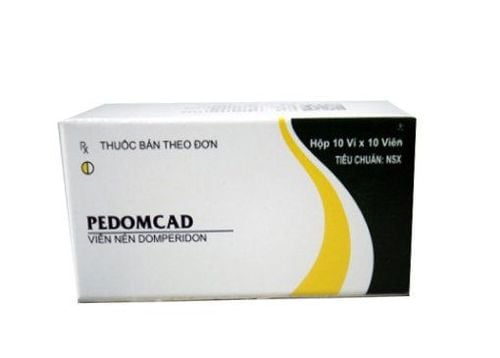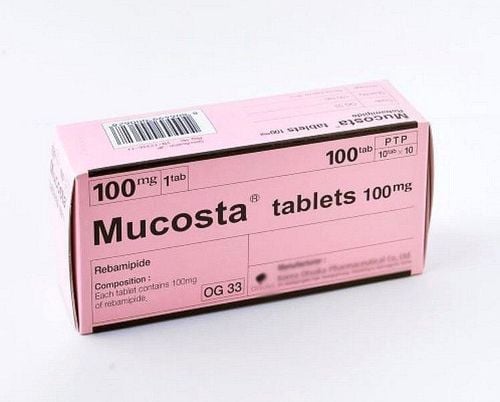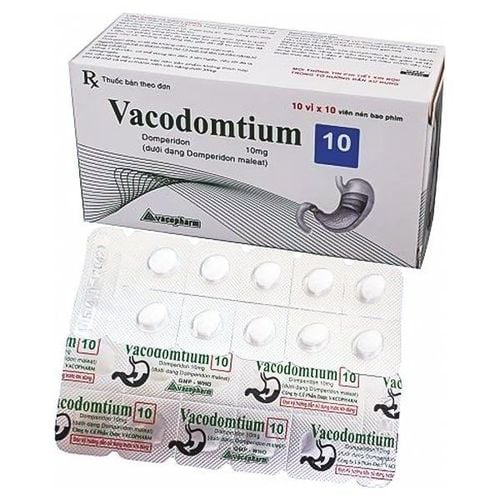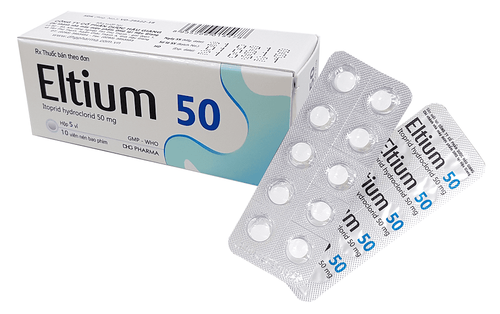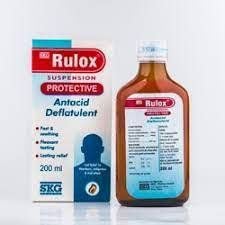This is an automatically translated article.
Gasompel-M is made in the form of tablets with the main ingredient Domperidone maleate. The drug is used to treat the symptoms of nausea and vomiting.
1. What are the effects of Gasompel-M?
In 1 tablet of Gasompel-M contains active ingredient Domperidone maleate equivalent to Domperidone 10mg and some other ingredients.
Domperidone is a dopamine antagonist with similar properties to metoclopramide hydrochloride. Because the drug Gasompel-M has almost no effect on dopamine receptors in the brain, it has no mental or neurological effects. Domperidone has the effect of stimulating peristalsis of the gastrointestinal tract, increasing the tone of the cardiac sphincter and increasing the amplitude of the pyloric sphincter expansion after eating, but does not affect the secretion of the stomach. It is used to treat the symptoms of acute nausea and vomiting, including nausea and vomiting, caused by taking bromocriptine or levodopa in people with Parkinson's disease.
Indications : Gasompel-M is indicated for the treatment of symptoms of vomiting and nausea. Specifically:
Nausea, vomiting, bloating, anorexia, dyspepsia, belching, heartburn in: Adults: Chronic gastritis, gastric prolapse, symptoms after gastrectomy, esophageal reflux , are taking anticancer drugs or L-dopa; Children: Periodic vomiting, taking anti-cancer drugs, upper respiratory infections. Contraindications : Do not use Gasompel-M in the following cases:
People with hypersensitivity to Domperidone or any of the ingredients in the drug; The patient vomited after surgery; People with gastrointestinal bleeding; People with mechanical intestinal obstruction; Patients with moderate to severe liver failure; Patients with prolonged cardiac conduction time (especially the QT interval), those with marked electrolyte disturbances, or those with existing cardiovascular disease (eg, congestive heart failure); Concomitant use with drugs that prolong the QT interval; Concomitant use with CYP3A4 inhibitors.
2. Usage and dosage of Gasompel-M
How to use: Should take Gasompel-M at the time before meals, if taken after meals, the drug may be absorbed slowly. The patient should take the medicine at a fixed time. The maximum duration of treatment should not exceed 07 days.
Dosage : Gasompel-M should only be used at the lowest effective dose for the shortest possible time to control vomiting and nausea.
Adults and adolescents (from 12 years of age and older and weighing 35kg or more): Take 10mg tablets, can be used up to 3 times/day with a maximum dose of 30mg/day; Infants, young children, children (age under 12) and adolescents weighing less than 35kg: Due to the need to use precise doses, effervescent tablets, tablets, and suppositories are not suitable for this group of patients. this statue; Hepatic Impairment: Gasompel-M is contraindicated in patients with moderate to severe hepatic impairment. No dose adjustment is required for patients with mild hepatic impairment; Patients with renal impairment: Due to the half-life of Domperidone in patients with severe renal impairment, if repeated use, the frequency of Gasompel M should be reduced to 1-2 times/day and the dose adjusted depending on the patient's renal function. degree of renal failure. Missed dose : If a dose of Gasompel-M is missed, the patient can skip that dose and continue taking the medicine according to the old schedule. Do not double the dose to make up for the missed dose as this can increase the risk of overdose and lead to many other negative side effects.
Overdose :
Overdosage with Gasompel-M has been mainly reported in infants and children. Symptoms of overdose may include: Altered perception, agitation, disorientation, convulsions, somnolence and extrapyramidal reactions; Management: There is currently no specific antidote to Domperidone, but in case of overdose, immediate symptomatic treatment should be instituted. Gastric lavage using activated charcoal may be beneficial for the patient. Attention should be paid to ECG monitoring because of the potential for prolongation of the QT interval. It is recommended that doctors and family members closely monitor the patient and provide supportive treatment. With anticholinergics, antiparkinsonian agents may be useful in controlling extrapyramidal reactions in patients with an overdose of Gasompel-M.
3. Side effects of the drug Gasompel-M
When using Gasompel-M, patients may experience some unwanted effects such as:
Domperidone hardly crosses the blood-brain barrier and is less likely to cause central nervous system effects. such as extrapyramidal reactions or somnolence. Extrapyramidal disturbances and somnolence occur at a very low rate and are usually caused by disturbances in the permeability of the blood-brain barrier (premature infants, meningeal lesions) or by overdose. Menstrual disturbances, amenorrhea, lactation, breast enlargement or breast tenderness due to elevation of serum prolactin may be observed in long-term high-dose users. The impact of Gasompel M on cardiovascular disorders is unknown, which can cause ventricular arrhythmias, torsades de pointes, prolongation of the QT interval, and sudden cardiac death. Patients need to pay attention to inform the doctor about the unwanted effects encountered during the use of the drug to receive advice on how to respond appropriately.
4. Be careful when using the drug Gasompel-M
Before and during the use of Gasompel-M, patients should pay attention to the following issues:
Renal impairment : The half-life of Domperidone is prolonged in patients with severe renal impairment. In case of repeated use, the frequency of domperidone should be reduced to 1-2 times/day depending on the degree of renal impairment. The dose of Gasompel-M can be adjusted if necessary.
Cardiovascular:
Domperidone can lead to prolongation of the QT interval on the electrocardiogram. During surveillance, there have been very few reports of QT interval prolongation and torsades de pointes associated with domperidone use; Studies have shown that Domperidone may increase the risk of sudden cardiovascular death or serious ventricular arrhythmias. This risk is higher for patients over 60 years of age, for patients taking daily doses above 30 mg, and for patients taking concomitant CYP3A4 inhibitors or drugs that prolong the QT interval; Domperidone should be used at the lowest effective dose in both adults and children, as directed by your doctor; Domperidone is contraindicated in patients with prolonged cardiac conduction time (especially the QT interval), patients with marked electrolyte disturbances (eg, hyperkalemia, hypokalemia, hypomagnesaemia) blood), slow heart rate or people with cardiovascular disease such as congestive heart failure because of the risk of ventricular arrhythmias. Electrolyte disturbances (hyperkalemia, hypokalemia, hypomagnesaemia) or bradycardia are factors that increase the risk of arrhythmias; Patients with any symptoms related to arrhythmia or cardiovascular disease should report it to their doctor quickly for timely treatment. Pregnant women and nursing mothers:
Pregnant women: Not much is known about the use of Gasompel-M in pregnant women. An animal study showed that the use of high doses of domperidone affected fertility. Therefore, domperidone should be used during pregnancy only when the benefit of treatment has been weighed against the possible risk to the fetus; Lactation: Domperidone is excreted in human milk. Adverse effects, especially cardiovascular effects, can still occur in breastfed infants. Therefore, it is necessary to carefully weigh the benefits and risks to decide whether to discontinue/avoid treatment with Domperidone or to discontinue breast-feeding. Caution should be exercised in cases of risk factors for prolongation of the QT interval in breastfed infants. Effects on ability to drive and use machines:
Domperidone has no or negligible influence on the ability to drive or use machines.
5. Gasompel-M drug interactions
Use of Gasompel-M increases the risk of QT prolongation due to pharmacokinetic or pharmacodynamic interactions.
Concomitant use of Gasompel-M with drugs as follows:
Drugs that prolong the QT interval: Class IA antiarrhythmic drugs, eg: Hydroquinidine, quinidine, disopyramide; Class III antiarrhythmic drugs, eg: Dronedarone, amiodarone, ibutilid, dofetilide, sotalol; Some antipsychotics such as: Pimozide, sertindole, haloperidol; Some antidepressants such as: Escitalopram, citalopram; Some antibiotics such as: Levofloxacin, erythromycin, spiramycin, moxifloxacin; Certain antifungal agents, eg: Pentamidine; some antimalarial drugs, especially lumefantrine, halofantrin; Some gastrointestinal drugs such as: Dolasetron, cisapride, prucalopride; Some antihistamines such as: Mizolastine, mequitazine; Some cancer treatment drugs such as: Vincamine, tamoxifen, vandetanib; Some other drugs such as diphemanil, bepridil, methadone. Strong CYP3A4 inhibitors (independent of their QT prolongation effects), eg: protease inhibitors; Systemic antifungal agents of the azole group; Some macrolide drugs such as: Telithromycin, clarithromycin, erythromycin. Concomitant administration of Gasompel-M with moderate CYP3A4 inhibitors is not recommended.
Use caution when co-administering Gasompel M with drugs that reduce blood potassium, bradycardia and some Macrolides that contribute to QT prolongation: Roxithromycin, azithromycin (clarithromycin is contraindicated because it is an inhibitory drug). strong CYP3A4.
To avoid the risk of drug interactions, patients should inform the doctor about the drugs they have/are taking so that appropriate adjustments can be made. During the use of Gasompel-M, patients and family members need to pay attention to strictly follow the instructions of the doctor, and read the instructions carefully before using it to limit the side effects and bring about benefits. high treatment efficiency.
Please dial HOTLINE for more information or register for an appointment HERE. Download MyVinmec app to make appointments faster and to manage your bookings easily.




